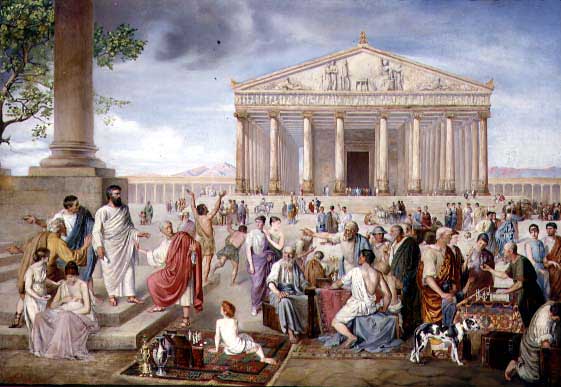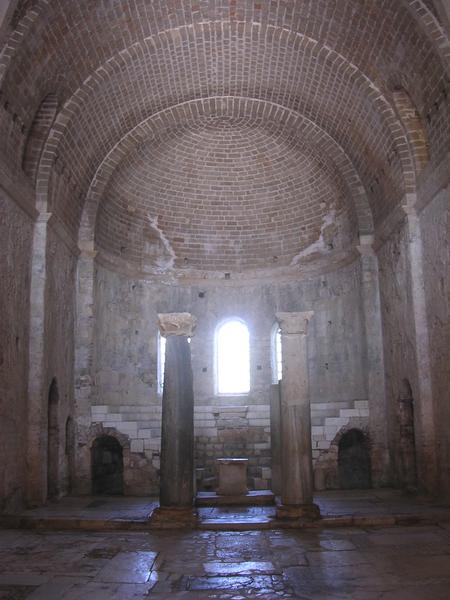Greek Orthodox tradition tells of
Saint Nicholas being born around 280 AD, the only child of a wealthy, elderly couple who lived in Patara, Asia Minor (present-day Turkey).

When his parents died in a plague,
Nicholas inherited their wealth.
Nicholas generously gave to the poor, but did it anonymously as he wanted the glory to go to God.

One notable incident was when a
merchant in town had gone
bankrupt.

The
creditors threatened to take, not only the merchants' assets,
but his children. 
The merchant had
three daughters. He knew if they were taken it would probably mean a life of sex-trafficking and prostitution.

The merchant had the idea of
quickly marrying his daughters off so the creditors could not take them.

Unfortunately,
he did not have money for a dowry, which was needed in that area of the world for a legally recognized wedding.
 Nicholas
Nicholas heard of the merchant's dilemma and
threw a bag of money in the window for the oldest daughter's dowry.
Supposedly
the bag of money landed in a
shoe or a stocking that was drying by the
fireplace.

It was the talk of the town when the first daughter got married.
Nicholas then threw a bag of money in the window for the
second daughter and she was able to get married.

Upon throwing money in for the
third daughter, the merchant ran outside and caught Nicholas.
 Nicholas made him promise not to tell where the money came from, as he wanted the credit to go to God.
Nicholas made him promise not to tell where the money came from, as he wanted the credit to go to God. 
This was the origin of the tradition of
secret gift-giving on the anniversary of
Saint Nicholas' death, which was
DECEMBER 6, 343 AD. 
The
three gold balls outside a pawnbrokers shop represent the
three bags of gold St. Nicholas used to rescue a family in their time of financial need.
 Get the book There Really is a Santa Claus - The History of St. Nicholas & Christmas Holiday Traditions
Get the book There Really is a Santa Claus - The History of St. Nicholas & Christmas Holiday Traditions 
St. Nicholas became
Bishop of Myra, a busy port city on the coast of Asia Minor.

Soon St. Nicholas was
arrested and
imprisoned during
Emperor Diocletian's brutal
persecution of Christians.St. Nicholas would not deny his faith in Christ!
St. Nicholas was freed when
Emperor Constantine ended Rome's three century long persecution of Christians.

When the first major heresy, the
Arian Heresy, began to split the Christian Church, Constantine ordered all the bishops to go to
Nicea to settle it, which they did by writing the
Nicene Creed. 
The tradition is that
St. Nicholas attended the
Council of Nicea and was so upset at
Arius for starting this heresy that
he slapped him across the face.Jolly Old St. Nick had a little temper!

St. Nicholas preached against sexual immorality and
Diana worship at Ephesus. The
Apostle Paul also had preached there according to the
Book of Acts, chapter 19.
The
Temple to Diana was one of the
Seven Wonders of the Ancient World, having 127 huge pillars . . . and
temple prostitutes. It was the Las Vegas of the Mediterranean world.
The people responded to
St. Nicholas' fiery preaching by
tearing down the local temple to Diana. St. Nicholas
St. Nicholas also stood up to corrupt government politicians.

One story was of a
corrupt governor who was about to execute some innocent soldiers in order to cover up his misdeeds.
 St. Nicholas
St. Nicholas broke through the crowd, grabbed the executioner's sword, threw it down and then exposed the governor's evil plot.

Greek Orthodox tradition attributes many
miraculous answers to
St. Nicholas' prayers.

Once a storm was so bad that fishermen and sailors were not able to get back to shore.

The people asked St. Nicholas to pray and the sea became calm enough for the fishermen and sailors to return safely to port.

This led to
St. Nicholas being considered the patron saint of sailors.
There Really is a Santa Claus-The History of Saint Nicholas & Christmas Holiday Traditions  St. Nicholas'
St. Nicholas' reputation grew so much that he became to
Greek Orthodox Christians what
St. Peter was to
Roman Catholic Christians.

In the 5th century a church in Myra was named after St. Nicholas, being rebuilt by
Emperor Justinian after an earthquake in 529.

In 988,
Vladimir the Great of Russia converted to Eastern Orthodox Christianity and adopted Nicholas as the
Patron Saint of Russia.

In the 11th century,
Muslim terrorists, the Seljuks Turks, invaded Asia Minor,
killing Christians, destroying churches and digging up the bones of Christian saints and desecrating them.

For protection, Christians shipped the remains of
St. Nicholas to a church in the town of
Bari in southern Italy in the year 1087.
 Pope Urban II
Pope Urban II dedicated the church, naming it after St. Nicholas - the
Basilica di San Nicola, thus introducing the
Greek St. Nicholas to Western Europe.

So many Christians were fleeing the Muslim invasion of Eastern Europe that
Pope Urban II went to the Council of Claremont in 1095 and called upon European leaders to send help.
Help was sent help - it was called the
First Crusade.

With
St. Nicholas' remains in Italy, western Europeans quickly embraced the gift-giving traditions associated with
St. Nicholas' Day - DECEMBER 6.  How did St. Nicholas become Santa Claus?
How did St. Nicholas become Santa Claus?By 1223, so much attention was being given to gift-giving during the Christmas season, that
Saint Francis of Assisi wanted to refocus the attention to the birth of Christ.

St. Francis created
the first creche or
nativity scene.
In 1517, Martin Luther began the
Reformation.
He ended all "saints days," including the popular
"St. Nicholas Day," considering them a distraction from Christ.
Since Germans like the gift-giving so much,
Martin Luther moved the gift-giving to December 25th to emphasize that
all gifts come from the Christ Child. 
The German pronunciation of Christ Child was
"Christkindl", which over the centuries got pronounced
Kris Kringle.

Greeks built on the prophecy of
Jesus returning at the end of the world to judge the living and the dead,
riding a white horse, and the
saints returning with him riding white horses.St. Nicholas will certainly be one of those returning saints.

Similar to Roman Catholics stories of St. Peter at the Gates of Heaven, the Greek have a story that
St. Nicholas comes back once a year for a sort of mini
pre-Judgement Day.
Over the centuries, the story evolved.
In Norway they did not have horses so
St. Nicholas is riding a reindeer.

Saints came heaven, the New Jerusalem, the
Celestial City - which turned into the
North Pole.

The
Lamb's Book of Life and
Book of Works turned into the
Book of the Naughty and the Nice. 
The
angels turned into
elves.

During Henry VIII's reign, Christmas in England became a time of partying and carousing. When Puritans took over England and outlawed Christmas as too worldly.

When the Puritans settled Massachusetts, they had a five shilling fine for anyone caught celebrating Christmas.
The Dutch loved Christmas and St. Nicholas traditions.

They embellished the story with St. Nicholas having a Moorish costumed helper who would put naughty children in sacks to take back to Spain to sell into Muslim slavery.

Eventually,
Dutch immigrants brought
St. Nicholas traditions to
New Amsterdam, which became
New York in 1665.

Dutch pronounced
Saint Nicholas as "
Sinter Klass," which became
"Santa Claus."  Washington Irvin
Washington Irving was the author of
Legend of Sleepy Hallow and
Rip Van Winkle.
Washington Irving also wrote
Diedrich Knickerbocker's A History of New York, 1809, in which he swapped out
St. Nicholas' Bishop's outfit for a
Dutch outfit of long-trunk hose, leather belt, boots and a stocking hat.  Clement Moore
Clement Moore wrote in 1823 "A Visit From
St. Nicholas":
'TWAS the night before Christmas,
when all through the house
Not a creature was stirring,
not even a mouse;
The stockings were hung
by the chimney with care,
In hopes that
St. Nicholassoon would be there..."
 Clement Moore
Clement Moore describe
St. Nicholas as smaller:
"He was chubby and plump, a right jolly old elf,
And I laughed when I saw him, in spite of myself...."
 Harper's Weekly illustrator Thomas Nast
Harper's Weekly illustrator Thomas Nast drew St. Nicholas visiting Union troops.
Thomas Nast, who was famous for inventing the
Republican elephant and
Democrat mule for his political cartoons, was the first artist to put a "North Pole" sign behind St. Nick as a subtle jab against the South during the Civil War.

In 1930,
Coca Cola hired artist Haddon Sundblom, famous for his
Quaker Oats man, to create a painting every year of "
Jolly Old St. Nick" drinking Coke.
Find out much more about Saint Nicholas and Christmas Traditions in the fascinating book:
 There Really is a Santa Claus-The History of Saint Nicholas & Christmas Holiday Traditions.Kirk Cameron mentioned Bill Federer's book in an interview about his new movie Saving Christmas
There Really is a Santa Claus-The History of Saint Nicholas & Christmas Holiday Traditions.Kirk Cameron mentioned Bill Federer's book in an interview about his new movie Saving Christmas